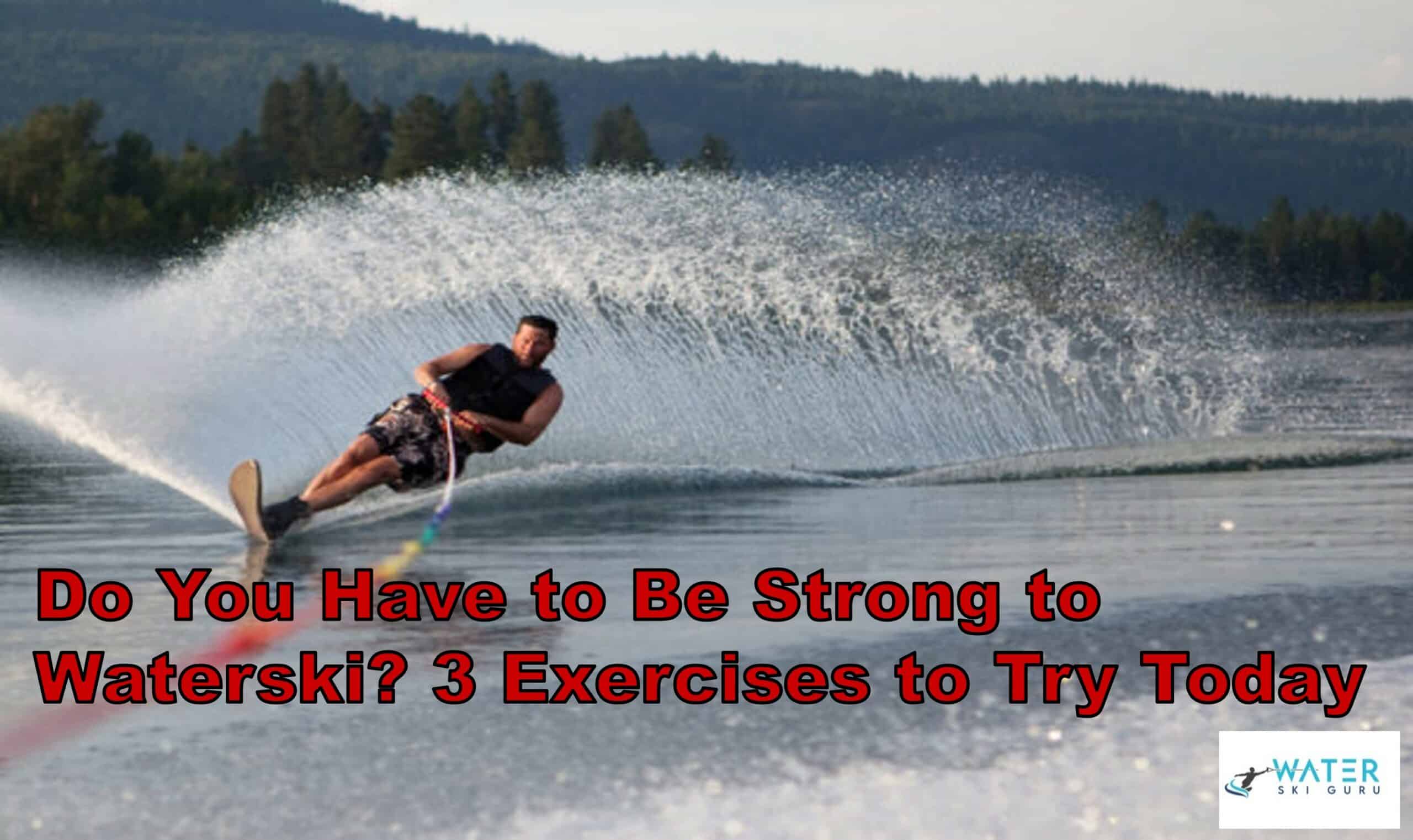Water skiing is a popular water sport that can be enjoyed by people of all ages and abilities. However, some people may wonder if they need to be strong to participate in this activity. The good news is that you do not have to be incredibly fit or muscular to enjoy water skiing!
Still, just like any other sport, you need to get your body ready for the physical demands of water skiing. So, whether you are a fitness enthusiast or a beginner who is just getting started with water sports, know that you can enjoy water skiing without being incredibly strong! You can’t be a couch potato either.
You don’t have to be a world-class athlete to water ski. However, skiing requires a strong body, great coordination, and good balance. Core strength is required for everything from getting up, turning, and crossing the wake. You also need good upper body strength as well as a strong lower back and legs.
While you don’t need to be a professional athlete, you do need to have a basic level of fitness to water ski. This means that you should be able to swim and have some experience with other sports or activities that require similar levels of coordination and balance.
So, if you are interested in giving water skiing a try, don’t let your lack of strength hold you back! With a little bit of practice and preparation, you can enjoy this thrilling water sport without any problem. Who knows, you may even end up becoming a pro!
Do You Have to Be Strong to Waterski?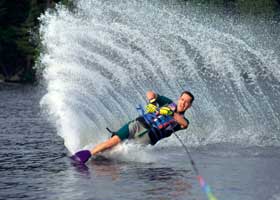
Water skiing is a difficult and strenuous activity that requires strength, coordination, and good body position control. Skiers need to have strong back and thigh muscles, as well as a robust core. While you’re skiing, your arms are engaged as you pull against the rope and your leg muscles are getting a workout absorbing the shock of skiing on the water.
While you don’t need to be a professional athlete, you should have some prior experience with other sports or activities that require strength, coordination and balance. You also should be able to swim and have a basic level of fitness.
Skiing requires a reasonably strong grip to hold the handle and keep the rope taunt. Your arms and shoulders have to have enough strength and power for you to get up out of the water and keep yourself balanced as you ski. All of the power in your arms is transferred to your legs through your core. The combination of a strong grip, arms, shoulders and core is what gives skiers the power they need to get up on their skis and stay there.
If you don’t have strong arms and legs, or if you’re not confident in your ability to balance and control your body, it’s going to be difficult to stay upright on your skis.
Check out this video outlining an exercise program to get in shape for water skiing.
What Muscles Do You Use to Water Ski?
Water skiing is an incredibly challenging sport that requires you to use your legs and thighs while staying in a semi-squatting position for long periods. You must also hold on tightly to the handle which requires a solid grip.
Water skiing requires you to use a variety of muscle groups. The main muscles engaged while skiing are:
Lower body muscles
Strengthening your lower body, as in your legs and thighs, is essential for water skiing. You will be required to stand on your legs while bending your knees slightly throughout the skiing session, and this requires strong thigh and leg muscles.
Your lower back is also engaged as it aids in the movement of your legs. Strong lower back muscles are essential for maintaining balance and control, as well as for providing power to your legs.
Upper body muscles
Your upper body muscles are involved in most of the movement while water skiing. You use your back muscles to control your body position and keep yourself balanced. Your shoulder muscles are engaged as you hold on to the rope and provide the power needed to get up out of the water and keep yourself skiing.
You also use your biceps and triceps to hold on to the rope and keep it taunt. And finally, your grip strength is important for keeping a firm hold of the handle.
Core muscles
Strong core muscles are important for water skiing as they provide stability and balance, and transfer power from your arms to your legs. A strong core also helps you maintain good posture while skiing.
Water skiing is a physically demanding sport that requires upper and lower body strength. Having a strong core allows you to put both muscle groups to work while you’re turning and crossing the wake. The stronger your core is, the more you can apply the power from your arms and legs to your skis. This, in turn, will make it easier to keep your balance and control your skis.
While you don’t need to be a professional athlete, you should have some prior experience with other sports or activities that require strength, coordination and balance. You also should be able to swim and have a basic level of fitness. If you’re not confident in your ability to balance and control your body
Water skiing is a whole-body experience. You need to have a very strict and consistent training routine because you will need almost every muscle in your body to get up on your skis, make tight turns, and cross the wake smoothly. It might sound like a lot of work -and it is- but it’s also a lot of fun. And the better you get, the more fun it becomes.
3 Exercises to Be a Better Water Skier
To become a better water skier, you need to work out your lower body and upper body muscles. It’s also important that you strengthen your core!
Luckily, there are some basic exercises you can do at home or in the gym to get yourself strong enough for water skiing.
1 – Dumbbell farmer walks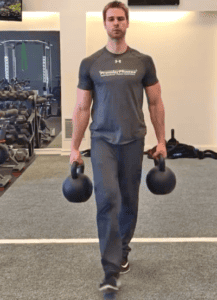
This exercise targets your shoulders, biceps, forearms, and upper back. These muscles are critical to being able to hold onto the ski rope and keep yourself upright.
Let’s see how it is done:
- Stand up straight with your feet in line with your shoulders
- Place a set of dumbbells on the floor next to each foot
- Squat down and grab a dumb bell in each hand
- Stand up while engaging your core muscles and pulling your shoulders down and back
- Begin walking at a steady pace while keeping your head up, back straight, shoulder back, and core muscle engaged.
The Dumbbell Farmer Walk will help increase your grip strength while exercising your muscles. Do this exercise and make sure you give yourself enough space to walk as long as you intend to.
2 – Lateral lunges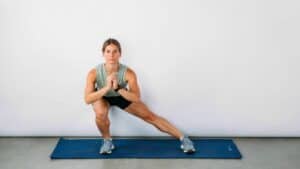
This exercise is also known as the side lunge. It targets your lower body muscles, such as the quadriceps, abductors, and hamstrings. Strong lower body muscles will help you count on your legs and thigh to pull you out of the water and to keep you in the right position while you’re skiing.
Here’s how you do a lateral lunge:
- Stand with your feet hip-width apart
- Tuck your chin in throughout the exercise as if you’re holding something with it
- Keep your hand on your hips’ side
- Take a wide step to the side with one leg and shift your body weight into it
- Bend your other knee and hips while sitting until your chin is in an upright position and your hands are clasped together in front of your chest
- Pause for a few seconds in this position
- Start to get back up by pushing your foot to the ground and keeping your chest upright.
Do two sets of repetitions on each leg to help exercise your lower body muscles. This exercise does not need any equipment and can easily be done at home.
3 – Pull-ups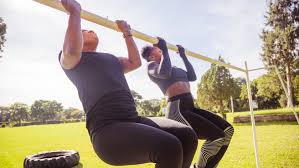
Pull-ups are a pretty well-known exercise, but they are also not the easiest to do. You will fail many times, but when you master your pull-ups, there is no better exercise to strengthen and test your upper body.
Here are the simple steps for doing masterful pull-ups:
- Stand up straight with your hand on the bar shoulder-width apart
- Put your chest out and curve your back
- Pull yourself up using your back muscles until the bar is at your chest
- Lower yourself back down while breathing deeply
You know that feeling when you try something new, and it just doesn’t work? That’s totally normal. All of those failed attempts at doing a pull up or lifting a heavy weight are really great learning experiences. So don’t get discouraged – keep trying!
FAQs
Is Water Skiing a Full Body Workout?
Water skiing is a full-body workout as it requires you to use your lower, upper, and core muscles in order to stay on the water. You will also need to have high endurance and a strong grip to keep yourself attached to the rope and be able to control your body’s movement throughout the exercise.
Is Water Skiing Hard on Your Knees?
Water skiing is hard on your knees and joints. You are required to stay in a slightly bent position for a very long time on your skis to uphold your balance. This position can be hard on your knees if you do not have strong lower body strength. In case of falling, you can also easily hurt your knees and break your bones.
Conclusion
Water skiing is a great way to spend a day out on the water. It’s also a great workout for your whole body. And, with a little practice and determination, you can improve your performance on skis. Just remember to stay strong, focus on your balance, and engage your core muscles. Have fun and enjoy the ride!

